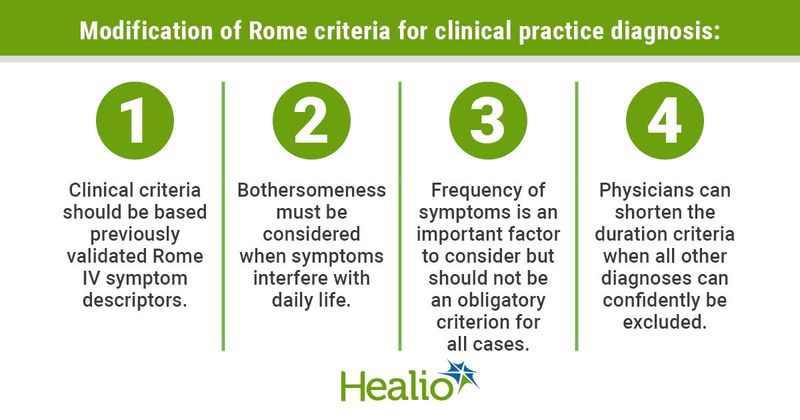The Rome Foundation translates clinical diagnostic criteria
Modification of the Rome criteria into the new clinical practice model may reduce unnecessary diagnostics and enhances the patient-provider relationship, according to research published in Gastroenterology.
“We are not modifying the standard Rome criteria which is required for epidemiological and clinical research. Rather, we are “translating” these criteria into clinical practice,” Douglas A. Drossman, MD, chief of operation for the Rome foundation, Center for Functional GI and Motility Disorders at the University of North Carolina, told Healio Gastroenterology. “What we have done is maintained the qualitative symptoms of the Rome IV Criteria, added the concept of “bothersomeness” to be sure that the symptoms are troublesome to the patient and suggested a reduction in the duration of symptoms to 8 weeks. In this way patients can be diagnosed and treated sooner.”

Aimed to fill the gap that exists for diagnosis with current Rome criteria for research which carries certain restrictions, Drossman and colleagues offered factors to consider that fall under the categories of symptom type, “bothersomeness,” frequency and duration. Proposed modification of Rome IV criteria for clinical practice and diagnosis follow.

- Clinical criteria should be based on Rome IV symptom descriptors and clusters which are consistent across populations and have been previously validated in study.
- The authors wrote that symptoms are bothersome when they interfere with daily life and the degree to which they bother a patient influences clinical judgement regarding treatment; they recommended the addition of “bothersomeness” as a clinical criterion for diagnosis.
- Though significant frequency of abnormal symptoms may be considered a clinically relevant criterion for diagnosis, some symptoms may be within normal frequency range while still impairing daily function. Frequency of symptoms should not be an obligatory criterion for all cases.
- Current criteria require at least 6 months of symptom onset and 3 months of meeting diagnostic criteria for diagnosis, excluding short-lived conditions. Physicians can now shorten the duration criteria when all other diagnoses can confidently be excluded.
“We would like to see studies in clinical practice that evaluate their impact on patient and provider satisfaction. We would also like to know if there is improvement in clinical outcomes for patients diagnosed earlier who may not have previously been diagnosed when using the traditional research criteria,” Drossman added. “Become familiar with the new Rome criteria and apply them in clinical practice. We have learned that many clinicians are tentative about making a diagnosis to their patients when criteria are not fulfilled. Now it will be easier, and patients will be more satisfied when the diagnosis is made with confidence.”
